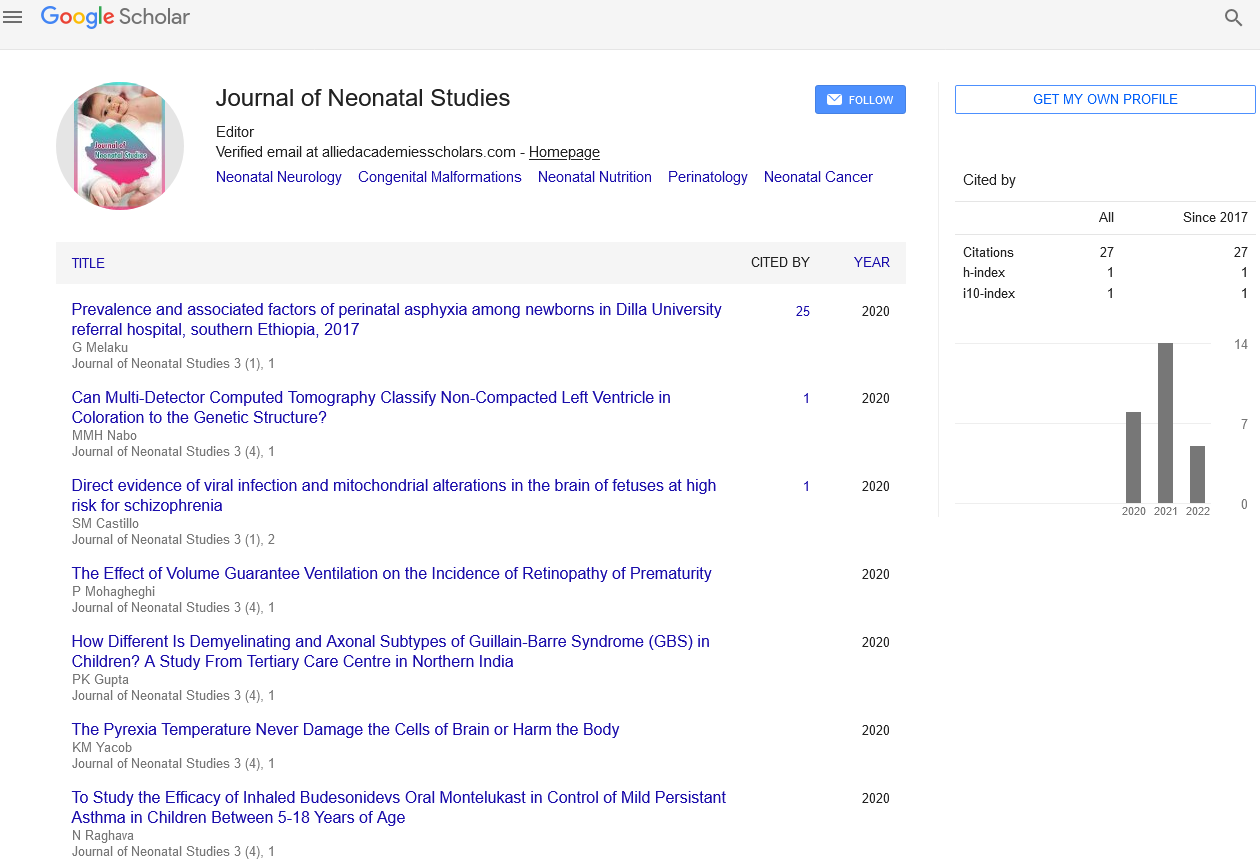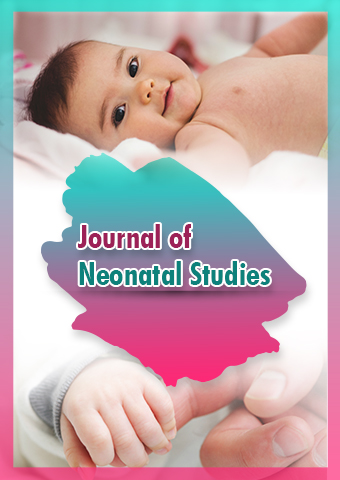Review Article - Journal of Neonatal Studies (2023) Volume 6, Issue 4
Neonatal Diseases & Disorders: A Comprehensive Overview
Afzal Khan*
Department of Stem Cell and Research, Macao
Department of Stem Cell and Research, Macao
E-mail: afzaalnahk@edu.co
Received: 01-Aug-2023, Manuscript No. jns-23-109482; Editor assigned: 2-Aug-2023, PreQC No. jns-23- 109482(PQ); Reviewed: 15-Aug-2023, QC No. jns-23-109482; Revised: 22-Aug-2023, Manuscript No. jns-23- 109482(R); Published: 29-Aug-2023; DOI: 10.37532/jns.2023.6(4).92-95
Abstract
Neonatal diseases and disorders encompass a wide spectrum of health conditions that affect infants during the first 28 days of life. These critical and vulnerable early stages demand prompt identification, accurate diagnosis, and effective management to ensure optimal outcomes. This review aims to provide a comprehensive overview of various neonatal diseases and disorders, shedding light on their etiology, clinical presentation, diagnostic methods, and available treatment options. By examining the prevalence, risk factors, and long-term consequences associated with these conditions, healthcare professionals can enhance their understanding of neonatal care, enabling timely interventions and improving neonatal health outcomes. The abstract delves into the most prevalent and life-threatening conditions faced by neonates, including infections, respiratory distress syndrome, congenital anomalies, neurological disorders, and metabolic disorders. By emphasizing the importance of early detection and multidisciplinary collaboration, this abstract aims to contribute to improved neonatal care and enhanced overall neonatal health. Neonatal diseases and disorders present a complex and critical set of challenges in pediatric medicine. The neonatal period, defined as the first 28 days of life, represents a vulnerable stage of human development, wherein infants are highly susceptible to various ailments that can significantly impact their survival and longterm health outcomes. This review aims to provide a comprehensive overview of the most common neonatal diseases and disorders, their pathophysiology, risk factors, clinical presentation, diagnosis, and management. Additionally, this study explores the impact of neonatal care advancements and interventions in reducing neonatal morbidity and mortality rates. The understanding of neonatal diseases and disorders is essential for healthcare professionals to enhance the quality of care and optimize outcomes for these delicate patients. By addressing the challenges and triumphs in managing neonatal diseases and disorders, this review aspires to contribute to the collective knowledge base and foster continued efforts to enhance neonatal care. Ultimately, a deeper understanding of neonatal health issues will enable healthcare professionals to offer more targeted and effective interventions, leading to improved survival and long-term well-being for these precious newborns.
Keywords
Neonatal diseases • Neonatal disorders • Newborn health • Neonatal care • Neonatal infections • Respiratory distress syndrome • Congenital anomalies • Neonatal neurology • Metabolic disorders • Early detection • Neonatal screening • Neonatal mortality • Neonatal morbidity • Multidisciplinary neonatal care • Neonatal advancements
Introduction
The neonatal period, encompassing the first 28 days of a newborn’s life, is a critical and vulnerable phase. During this time, infants are highly susceptible to a wide range of diseases and disorders that can significantly impact their health and development. Neonatal care has made remarkable strides in recent decades, leading to improved survival rates and better overall outcomes.
However, neonatal diseases and disorders remain a significant concern for healthcare professionals and parents alike [1].
The etiology of neonatal diseases can be multifactorial, with genetic, environmental, and prenatal factors playing pivotal roles. Despite the remarkable advancements in medical science and neonatal care, these conditions continue to pose considerable challenges to healthcare providers, necessitating constant vigilance and research to improve outcomes. This review will explore some of the most prevalent neonatal diseases and disorders, including but not limited to prematurity and its associated complications, respiratory distress syndrome, neonatal sepsis, birth asphyxia, congenital anomalies, and metabolic disorders. Understanding the pathophysiology and risk factors associated with each condition is crucial for early identification, timely intervention, and better management [2].
By addressing the challenges and triumphs in managing neonatal diseases and disorders, this review aspires to contribute to the collective knowledge base and foster continued efforts to enhance neonatal care. Ultimately, a deeper understanding of neonatal health issues will enable healthcare professionals to offer more targeted and effective interventions, leading to improved survival and long-term well-being for these precious newborns [3].
Discussion
Causes and risk factors
Neonatal diseases and disorders can be caused by various factors, including genetic, environmental, and maternal health conditions. Some conditions may be present at birth (congenital), while others might develop during the neonatal period due to infections or complications during pregnancy and childbirth.
Genetic disorders
Certain conditions are caused by abnormalities in the baby’s genes or chromosomes. Examples of genetic disorders include Down syndrome, cystic fibrosis, and congenital heart defects [4].
Infections
Neonatal infections can occur during pregnancy, childbirth, or postnatal exposure. Common infections include Group B Streptococcus (GBS), neonatal sepsis, and Congenital Cyto Megalo Virus (CMV) infection.
Premature birth
Babies born prematurely have an increased risk of various health problems, including respiratory distress syndrome, intra ventricular hemorrhage, and necrotizing enterocolitis [5].
Low birth weight
Babies born with a low birth weight (less than 5.5 pounds) are at higher risk of several complications, such as respiratory issues, infections, and developmental delays.
Maternal health conditions
Certain maternal health conditions, such as gestational diabetes, preeclampsia, and maternal infections, can increase the likelihood of neonatal diseases.
Environmental factors
Exposure to toxins or harmful substances during pregnancy or in the early postnatal period can lead to health issues in newborns [6].
Common neonatal diseases & disorders
Respiratory distress syndrome (RDS) RDS is a common condition in premature infants caused by insufficient surfactant production, leading to breathing difficulties.
Jaundice
Jaundice occurs when a newborn’s liver is unable to break down bilirubin effectively, resulting in a yellowing of the skin and eyes.
Necrotizing entero colitis (NEC)
NEC is a serious intestinal condition that primarily affects premature babies and can lead to tissue death in the intestine.
Patent ductus arteriosus (PDA)
PDA is a heart condition where the ductus arteriosus, a blood vessel that should close after birth, remains open, causing circulation problems [7].
Hypoxic-ischemic encephalopathy (HIE)
HIE results from a lack of oxygen and blood flow to the brain, leading to brain damage.
Neonatal sepsis
This is a severe bloodstream infection in newborns, often caused by bacteria, and can be life-threatening if not treated promptly.
Congenital heart defects (CHD)
Structural abnormalities in the heart can lead to congenital heart defects, affecting the heart’s function and circulation.
Diagnosis and treatment
Timely diagnosis and appropriate treatment are crucial for managing neonatal diseases and disorders effectively. Newborns undergo routine screenings and assessments to detect any potential issues and high-risk infants may receive additional monitoring and testing [8].
Diagnostic tests
Common diagnostic tests include blood tests, ultrasounds, echocardiograms, X-rays, and genetic testing.
Medical interventions
Treatments may include antibiotics for infections, respiratory support for breathing difficulties, surgery for congenital defects, and phototherapy for jaundice.
Nutritional support
Proper feeding and nutritional support are essential for the healthy development of newborns, especially preterm or low-birthweight infants [9].
Medications
Depending on the condition, newborns may be prescribed medications to manage symptoms and support their recovery.
Surgery
Some neonatal conditions may require surgical intervention, such as correcting congenital anomalies or repairing certain organ defects.
Prevention and care
While not all neonatal diseases can be prevented, there are essential steps parents and healthcare providers can take to promote neonatal health
Prenatal care
Regular prenatal check-ups and a healthy lifestyle during pregnancy can reduce the risk of complications.
Vaccination
Ensuring the mother is up-to-date with vaccinations and receiving appropriate immunizations for the newborn can help prevent certain infections.
Avoiding toxins
Pregnant women should avoid exposure to harmful substances, including smoking, alcohol, and illicit drugs.
Breastfeeding
Breastfeeding provides numerous benefits for newborns, including enhanced immunity and better nutrition [10].
Infection control
Implementing strict infection control measures in the neonatal intensive care unit (NICU) can reduce the risk of hospital-acquired infections.
Conclusion
Neonatal diseases and disorders pose significant challenges for both healthcare professionals and parents. Early diagnosis, prompt intervention, and comprehensive care are essential for improving outcomes and reducing the burden of neonatal health issues. As medical research and technology continue to advance, we can hope for better prevention, diagnosis, and treatment options to ensure a healthier start for every newborn. Equally important is the role of education and awareness, empowering parents and caregivers with knowledge to provide the best possible care for their precious little ones during this delicate phase of life. Neonatal diseases and disorders are a critical aspect of pediatric medicine that demands constant vigilance, early detection, and comprehensive management. The vulnerable neonatal period, encompassing the first 28 days of life, presents a unique set of challenges for both medical professionals and parents alike. This period is characterized by rapid growth and development, making neonates particularly susceptible to a wide range of health issues.
Ultimately, our collective efforts in understanding, preventing, and treating neonatal diseases and disorders hold the promise of a healthier future for the most vulnerable members of society – our newborns. By working together, we can significantly reduce the burden of neonatal illnesses and pave the way for a brighter, healthier start to life for generations to come.
Acknowledgement
None
Conflict of Interest
None
References
- Acharya UR, Faust O, Sree V et al. Linear and nonlinear analysis of normal and CAD-affected heart rate signals. Comput Methods Programs Bio. 113, 55–68 (2014).
- Kumar M, Pachori RB, Rajendra Acharya U et al. An efficient automated technique for CAD diagnosis using flexible analytic wavelet transform and entropy features extracted from HRV signals. Expert Syst Appl. 63, 165–172 (2016).
- Davari Dolatabadi A, Khadem SEZ, Asl BM et al. Automated diagnosis of coronary artery disease (CAD) patients using optimized SVM. Comput Methods Programs Bio. 138, 117–126 (2017).
- Patidar S, Pachori RB, Rajendra Acharya U et al. Automated diagnosis of coronary artery disease using tunable-Q wavelet transform applied on heart rate signals. Knowl Based Syst. 82, 1–10 (2015).
- Giri D, Acharya UR, Martis RJ et al. Automated diagnosis of coronary artery disease affected patients using LDA, PCA, ICA and discrete wavelet transform. Knowl Based Syst. 37, 274–282 (2013).
- Maglaveras N, Stamkopoulos T, Diamantaras K et al. ECG pattern recognition and classification using non-linear transformations and neural networks: a review. Int J Med Inform. 52,191–208 (1998).
- Rajkumar R, Anandakumar K, Bharathi A et al. Coronary artery disease (CAD) prediction and classification-a survey. Breast Cancer. 90, 945-955 (2006).
- Dwyer, Claire. ‘Highway to Heaven’: the creation of a multicultural, religious landscape in suburban Richmond, British Columbia. Soc Cult Geogr. 17, 667-693 (2016).
- Fonseca, Frederico Torres. Using ontologies for geographic information integration. Transactions in GIS.6,231-257 (2009).
- Harrison, Paul. How shall I say it…? Relating the nonrelational .Environ Plan A. 39, 590-608 (2007).
Indexed at, Google Scholar, Crossref
Indexed at, Google Scholar, Crossref
Indexed at, Google Scholar, Crossref
Indexed at, Google Scholar, Crossref
Indexed at, Google Scholar, Crossref
Indexed at, Google Scholar, Crossref

